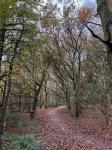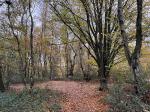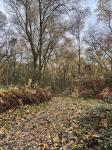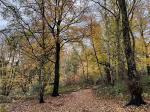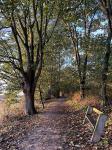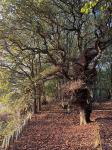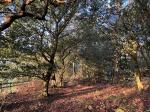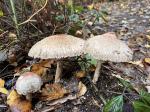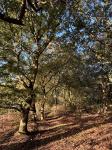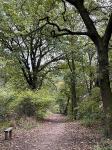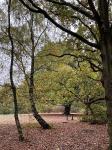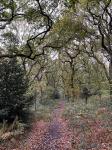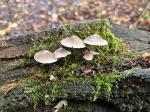Brayton Barff Through the Seasons.
Set in the Vale of York, South West of the market town of Selby and between the villages of Thorpe Willoughby and Brayton, lies Brayton Barff, a sandstone Hill approximately one hundred and fifty feet in height which was formed by glacial movement during the last Ice Age. It is a significant landmark in an otherwise flat landscape.
Today the site is primarily owned by Yorkshire Water with Selby District Council owning a small patch of the land adjacent to the A63 Selby bypass. A large underground reservoir occupies the centre of the site which delivers water to around 4.7 million customers throughout Yorkshire.
Within the Barff woodland over 40% of the trees are Sessile Oak which are generally found in semi natural woodlands in the north of the country. These trees are so called because its acorns are not held on stalks, like those of the English Oak (Pedunculate), but attached directly to the outer twigs. There are also several English Oak trees as well as some cross-hybrid oaks. These trees are known to support many species of flora and fauna, invertebrates, mosses, lichen and fungi.
During the Victorian times it is thought that the shipbuilders on the east coast would come over to the Barff for selected cuts of timber to build their sea going vessels.
The Barff also has a variety of other trees including Silver Birch, Beech, Sycamore, Holly, Rowan, Scots Pine, Alder, Hawthorne and European Larch. There are also several Yew, Willow, Hazel, Horse Chestnut and Wych Elm. As with similar woodlands there are a variety of bushes, including Honeysuckle, Elderberry, Gorse, Broom and Buddleia.
The history of Brayton Barff is quite vague, apparently during 1803 a beacon was lit on the Barff when the country was threatened with an invasion by Napoleon. In May 1935, to celebrate King George V's Silver Jubilee, a Bonfire was lit on the Barff as part of the celebrations.
Early issues of Ordnance Survey Maps dated 1903 clearly show a rifle range on the Barff, extending out to Mill Lane. During the 
Between 2001 – 2004 the A63 Selby bypass, 10km twin lane single carriageway was constructed which severed the South West corner of the Barff, adjacent to Selby Golf Course and resulted in a slight redesign of several holes on the golf course. Wooden fencing was erected as a result of this new road running alongside of the Barff and a footbridge constructed over the ‘new road’ following the line of the Bridal way which extends from Mill Lane. Around 2005/2006 a definite 2metre wide limestone aggregate footpath was laid forming a circular path around the outer edges of the woodland. This footpath is approximately 1.2 miles in length and takes about 30 minutes to circumnavigate at a leisurely pace.
In 2012 the Barff was declared an Ancient Oak Woodland and as such throughout 2012 and 2013 significant work had been carried out by the relevant agencies to cut and remove large swathes of non-native trees, creating at that time huge scars on the landscape. Some three years later the planting of the native trees have become well established and are flourishing. Ongoing maintenance work on the footpath around the bottom of the Barff was completed during the Summer of 2016.
A second phase of woodland maintenance commenced during the Autumn of 2019 with the removal of many old and diseased trees and the cutting back of the Gorse and Broom bushes, especially adjacent to the ‘bypass trail’, this work continued through till March 2020 with re planting continuing into April 2020.
Brayton Barff is a popular site for walkers and bird watchers alike and a path circling the outer perimeter of the Barff makes a pleasant thirty minute walk, giving views looking over towards Selby and the village of Brayton as well as the power stations of Drax and Eggborough..jpg)
For the early risers it is a great place to see some stunning sunrises over the villages of Brayton looking towards Drax Power Station, the same with the Sunsets looking over towards Eggborough and Monk Fryston.
The Barff changes with the Seasons and every visit can reveal something new, the woodland is a haven for wildlife. Records show that since 1982 one hundred and twelve species of bird have been seen in the woodland and at least 40 of those have bred here, including Tawny Owl, Buzzard, Green Woodpecker, Spotted Flycatcher, Goldcrest and Nuthatch to name just a few. On average over 70 species of bird are recorded each year. Further details of the bird life on the Barff can be found on the Brayton Barff Group Facebook page, especially the posts from Derek Cooper. Today ‘The Friends of Brayton Barff group’ led by Derek and a small team of volunteers help keep and maintain the cleanliness of the site as well as recording the wildlife and bird sightings.
The Barff is also home to fifteen different species of mammals, including Muntjac Deer, Pipistrelle Bat, Fox, and Field Vole.
Over eighty species of plant and wildflowers have been recorded, included Bee Orchid, Northern Marsh Orchid, Wood Anemone, Marsh Ragwort, Bluebell, White Bluebell, Bittersweet and Purple and White Foxgloves. Over twenty species of Butterfly have been recorded, including Marbled White, Brown Angus, Speckled Wood, Comma and Brimstone.
During the Autumnal months fungi thrives in this woodland environment, species including Fly Agaric, Beefsteak Tree Fungi, Chicken of the Wood, Sulphur Tufts, Stinkhorn, Ink cap, Puffballs and Hoof Bracket are just some of the many varieties that can be found here.
Click on the galleries shown below to expand the albums.
November 2022
No sooner has November arrived than here we are at the end of the month with the onset of winter on our doorstep.
November has been a wet month, although slightly warmer than average, although this was hardly noticeable due to the unsettled weather across the county. It seems that we had rain almost every day, and if not during the day, then we certainly had a lot of rain during the night, in fact the records show that the country had double the monthly average rainfall for November. I hope much of this water has gone some way to replenish our depleted reservoirs. Hopefully in the next week or so Yorkshire Water will ease the hosepipe ban.
The Barff has been an absolute picture during the Autumn months, the colour palette changes on a daily basis, depending on the weather, but when the sun shines through the trees the colours are magnificent, producing a rich tapestry of colours, including, golds, yellows, and bronzes which brighten up the surrounding area. As I write this note, many of the trees have still to shed their leaves, some of the older Oak, Beach and Birch trees seem very reluctant to let go of their leaves, though we have only had a handful of light frosts of late, no doubt over the coming few weeks and once the colder winter weather kicks in, the trees will shed the remainder of their leaves as they prepare themselves for the colder winter months.
What I have been amazed at is the large number of fungi about, the weather and temperatures during October and November has been much warmer and humid than usual for this time of year, and the woodland has provided the ideal habitat for it to grow and flourish, many varieties seem to appear overnight, especially the Sulphur Tuft and Shaggy Parasols. Birch Polypore seems to thrive all year round. I have also noticed several Fly Agaric in the usual places still popping through the leave litter. One of my favourite fungi is the delicate Candle stick fungi, which can be found popping up through the moss-covered tree stumps on the woodland floor. Other fungi of note are the Turkey tail, Dead Man’s Finger (Xylaria polymorpha), similar to the Candle stick fungi, but black, and Hoof Bracket Fungi.
Gray Squirrels can be seen and heard most days, running up and down the tree trunks and skurrying across the tree branches at breakneck speed. They should manage nicely through the winter months with the bumper crop of Acorns this year. Gray Squirrels do not hibernate and can be seen all year round in the woodland and around the bird feeders in the main car park, where they can get a free meal from the bird feeders.
I have not seen the Buzzard as frequently as I have previous months, neither the Tawny Owls, though that is probably due to the times I have been visiting the Barff as well as the wet rainy weather of late. From reading other reports I know they are still there, it is just that I have been in the right place at the wrong time of day! Most of our regular birds can still be seen though, Nuthatches are still vocal, as are the Robins, Wrens, Gold crest, Great & Blue Tits, Chaffinch and Dunnocks. I always like to watch the Tree Creepers as they run up and down the tree trunks at ease, whilst they search for grubs with the aid of their long-curved beak, which they ably use to prize the grubs out from the tree bark.
Looking at the weather forecast for the next few weeks, I think I better get my warmer winter clothing out in preparation for a cold winter snap.
|




